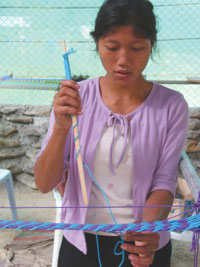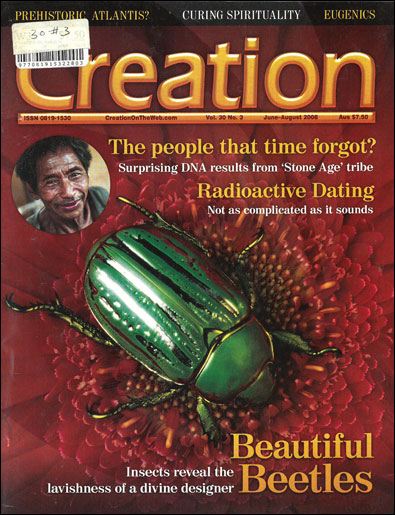The people that forgot time (and much else, too)

Isolated hunter-gatherer tribes are often viewed in the West as being primitive (pre-agriculture), not-yet-fully-evolved relics of the Stone Age.1,2 Such people are frequently dubbed ‘The People That Time Forgot’—a concept widely recognized, even by those unfamiliar with Edgar Rice Burrough’s classic 1924 novel (or the 1977 Hollywood movie).3
However, faced with intriguing new evidence, anthropologists are having to completely rethink the ‘Primitive Worlds: People Lost in Time’4 stereotype.
The Mlabri—‘People of the Yellow Leaves’
Ranging through mountain forests across parts of northern Thailand and western Laos, the Mlabri people were first ‘discovered’ by Europeans in 1936. They had no agriculture, instead they hunted and foraged for wild food in the jungle—the region’s only hunter-gatherers.
The Mlabri lived as forest nomads, moving frequently and rarely showing themselves to outsiders. However, Thai people knew of their existence, calling them Phaw Tong Luang—‘People of the Yellow Leaves’.5 This is because they would abandon their temporary bamboo-stick dwellings, thatched with banana leaves, after a week or so when the leaves turned yellow.

Their enigmatic lifestyle caused anthropologists to conclude that the Mlabri had ‘descended through the ages unchanged’, perpetuating a culture that ‘predates agriculture’. In short, scientists considered that the Mlabri people were ‘relics of the Stone Age’.6
But one of the neighbouring hill tribes—the Tin Prai, an agricultural people—tell a very different account of the Mlabri’s origins.
The Tin Prai ‘legend’—boy, girl, sent down river

The Tin Prai have a story, passed down from generation to generation, to explain the origin of their secretive hunter-gatherer neighbours.
Several hundred years ago, the Tin Prai say, they banished two of their young children from their farming community, sending them down-river on a raft. The children—a boy and a girl—survived and escaped into the jungle. They kept themselves alive by gathering the ‘fruit of the forest’ and hunting what they could—and, in time, had offspring of their own. Thus the banished boy and girl, according to the Tin Prai, became the founders of the Mlabri tribe.
But this account was labelled by others as ‘tribal myth’—it simply did not fit with the recognized evolutionary progression for the development of human cultures, i.e., ‘hunter-gathering predates farming, not the other way around’.7
Mlabri DNA ‘astonishing’
The Mlabri today consist of around 300 people and are considered ‘a vulnerable people with threatened lifestyle and language’.7,8 Much of their original ranging land has been ‘lost’ to logging and encroaching farms.

An international team of anthropologists,9 hoping to ‘uncover clues to evolutionary origins’, set out to compare the genetic diversity of the Mlabri with that of six agricultural hill tribes.10,11
The results were ‘remarkable’. As ScienceNOW reported: ‘Astonishingly, all of the Mlabri mitochondrial DNA turned out to be identical—a total lack of variation that hasn’t been found in any other human population.’6 Similarly, the Mlabri Y chromosome and autosome genetic diversity was ‘also extraordinarily reduced’.
The implication? Because the Mlabri are genetically ‘nearly identical’, they must have come from ‘a very limited gene pool’.7 In fact, the researchers conclude that the Mlabri population descends from just one female and from just one to four males, who lived about 500 to 800 years ago. And because of the similarities in genetic makeup between the Mlabri and agricultural hill tribes, the researchers conclude that ‘the most probable explanation for the origin of the Mlabri is an extreme founder event from an agricultural group, followed by adoption of a hunter-gathering lifestyle.’11 And that neighbouring agricultural group was ‘at least closely related to the present-day Tin Prai’.7
‘Strange tale’ not so strange!
In addition, linguistic studies have shown that the Mlabri language is related to that of the Tin Prai—probably diverging a few hundred years ago.7,11
Thus the Tin Prai’s ‘strange tale’ (as one news report7 dubbed it) turns out to fit the facts. It would have been better regarded as a handed-down eyewitness account. The Mlabri were not a pre-agricultural ‘people that time forgot’. Rather, faced with having to survive in the jungle and cut off from access to crop seed resources and community support networks, they were people who forgot the know-how needed to farm12 and a whole lot of other things their ancestors had known—making clothes, sturdy dwellings, social laws, etc.
Given the young ages of their founders, this lack of handed-down wisdom from their elders is understandable. The Tin Prai say it also explains ‘why the Mlabri are so childish’ and ‘why they speak so slowly’.7,13 It also explains why Mlabri society was vulnerable to distinctly unwise notions, e.g., their customs prohibit land ownership.14 This is said to condemn them to a life of low-income labouring and poverty.
‘Cultural reversion’?

In light of their findings about the Mlabri, the researchers warn that ‘contemporary hunter-gatherer groups cannot be automatically assumed to represent the pre-agricultural lifestyle of human populations, descended unchanged from the Stone Age.’11
They point to other hunter-gatherer groups too, known to have descended from agricultural peoples. For example, the Polynesian hunter-gatherers on the Chatham Islands and the South Island of New Zealand, ‘who abandoned agriculture and adopted a maritime-based foraging subsistence’.
But this does not mean that the researchers have abandoned evolutionary theories. They still hold that there was a pre-agriculture ‘Stone Age’, and speak of such examples as ‘cultural reversion’. But if asked, they would be hard-pressed to provide definitive evidence that people started out as ‘Stone Age’ hunter-gatherers, with agriculture ‘evolving’ later. Just as with the Mlabri, the indications from genetic, linguistic and folkloric evidence pertaining to other hunter-gatherer peoples today point strongly to their being related to agricultural peoples, but having suffered ‘cultural devolution’.15–17 There never was a ‘Stone Age’, except in the minds of those who presuppose an evolutionary ‘history’!18 The only way of definitively knowing what happened in the past is to have reliable eyewitness testimony (Deuteronomy 19:15; Job 38:4,21; 2 Corinthians 13:1). And the Bible is exactly that—going back to the very beginning of time—from the Creator Himself.
The people that forgot time—deliberately!
In 2 Peter 3:3–7, the Bible warns us that “in the last days scoffers will come, scoffing and following their own evil desires”. It goes on to say that “they deliberately forget that long ago by God’s word the heavens existed and the earth was formed out of water and by water. By these waters also the world of that time was deluged and destroyed” (emphasis added).19
Because evolutionists forget about the global Flood (Genesis 6–9) around 4,500 years ago, they think that sedimentary rock layers represent millions of years. Because they forget that the whole Creation is only around 6,000 years old and that the first man tended a garden and planted the crops of the field, they say that hunter-gathering preceded agriculture. Because they forget what happened at the time of Adam, then Noah and later the dispersion from Babel, they falter in trying to explain death, suffering, fossils and the origin of languages and cultures. Even more seriously, because they forget that the first man and woman were made in the image of God (Genesis 1:26–27), that all people are descended from them and have been intelligent from the very beginning (e.g. forging tools out of metal—Genesis 4:22), they’ve replaced the true history of man with a story that implies some people are ‘less evolved’ (and thus less human) than others—fuelling racism.20

Even where overt racism is not manifest,21 nevertheless the replacing of the Bible’s timeline with the evolutionary timeline can hit people hard (in a hurtful and debilitating sense). For example, many Aboriginal people in Australia have accepted evolution’s lie that for at least 40,000 years they’ve been living a ‘Stone Age’ existence—by implication more primitive (less evolved) than the rest of the population.22 Such a destructive notion can be overcome by proclaiming the truth about our origins. Christian preachers visiting Aboriginal communities have reported seeing tears of joy resulting from the realization that we are all ‘one race’, all descended from Adam and Eve (and later, Noah), and thus all equally made in the image of God our Creator.23,24
This is knowledge that their ancestors at some point would have had (along with knowledge of agriculture, metalworking, making clothes, etc.), but which for some reason has not been passed down to subsequent generations. In short, they’ve forgotten.
Many people in the ‘Christian’ West, too, are in danger of forgetting, given the widespread parading of the evolutionary timeline as ‘fact’ through the media, schools and universities, at the same time as children’s exposure to biblical teaching is diminishing.
We would do well to remember the Bible’s emphasis (e.g. Deuteronomy 4:9–10, 31:10–13; Ephesians 6:4) on passing on the knowledge of God’s Word (which includes the correct history of time) to the next generation—our children—so they in turn can pass it on to their children, and so on.
Lest we (and they) forget.
References and notes
- Houser, E., A summary of: Headland, T., and Reid, L., Hunter-gatherers and their neighbors from prehistory to the present, Current Anthropology 30(1):43–66, 1989; <www.publicanthropology.org/Archive/Ca1989.htm>. Return to text.
- Stone Age tribe kills castaways, The Age (Melbourne, Australia), <www.theage.com.au/news/world/stone-age-tribe-kills-cast aways/2006/02/09/1139379613195.html>, 9 February 2006. Return to text.
- The book’s character travels to a ‘lost’ continent which has living dinosaurs and ‘savage proto-men’. Burroughs was also the creator of the ‘jungle hero’ Tarzan. Return to text.
- The title of a well-known 1973 book by the National Geographic Society (US). Return to text.
- Alternatively: Phi Tong Luang—‘Spirits (or Ghosts) of the Yellow Leaves’. Return to text.
- No Stone Age unturned, ScienceNOW, <sciencenow.sciencemag.org/cgi/content/full/2005/308/4>, 8 March 2005. Return to text.
- Studies back up strange tale of tribe’s founding, World Science, <members.aol.com/newssciencepage/050303_mlabri.htm>, 4 March 2005. Return to text.
- Watt, B., Mlabri People, <www.mlabri.org>, 17 March 2005. Return to text.
- Led by Prof. Dr Mark Stoneking, Dept. of Evolutionary Genetics, Max Planck Institute for Evolutionary Anthropology, Germany. Return to text.
- An evolutionary road less traveled: from farming to hunting and gathering, Public Library of Science—Biology 3(3):e116, March 2005. Return to text.
- Oota, H., Pakendorf, B., Weiss G., von Haeseler A., Pookajorn S., et al., Recent origin and cultural reversion of a hunter-gatherer group, Public Library of Science—Biology 3(3):e71, 2005. Return to text.
- The Mlabri vocabulary and folklore also give some evidence of an ancient familiarity with agriculture. Ref. 11. Return to text.
- Post-Babel language degradation is well-documented. Languages do not evolve, they ‘devolve’, losing complexity from generation to generation. See Wieland, C., Towering change, Creation 22(1):22–26, 1999; <creation.com/babel>. Return to text.
- Unlike the Bible, which teaches the value of private property—e.g. Matthew 20:15; 1 Kings 4:25—commandments against stealing and coveting presuppose private property. Return to text.
- Wieland, C., Tasmanian aborigines—another example of cultural ‘devolution’, Creation 2(1):18–19, 1979, <creation.com/tasaborig>. Return to text.
- Wieland, C., Culture clash, Creation 17(3):42–44, 1995; <creation.com/clash>. Return to text.
- Catchpoole, D., The Australian dingo—a wolf in dog’s clothing, Creation 27(2):10–15, 2005, <creation.com/dingo>. [Note dogs in top photo] Return to text.
- Niemand, R., The Stone ‘Age’—a figment of the imagination?, Creation 27(4):13, 2005, <creation.com/stone>. Return to text.
- New International Version. Return to text.
- Wieland, C., Evolutionary racism, Creation 20(4):14–16, 1998; <creation.com/evolracism>. See also p. 10 this issue. Return to text.
- Modern evolutionists do not generally have racist views, but this is in spite of, not because of, their Darwinism. The increasingly evident biological closeness and relatedness of all humans, predictable on a biblical basis, has led to human evolution theories becoming drastically modified to accommodate the data. Return to text.
- Walker, T., National emergency in Australia—The fruit of forty years of evolutionary policies, <creation.com/aboriginalemergency>, 29 June 2007. Return to text.
- ‘I almost began to believe what evolutionists were saying about us’, Prayer News [CMI–Australia], p. 3, October–December 2002. Return to text.
- The Creation Bus ministry, <creation.com/bus>. Return to text.


Readers’ comments
Comments are automatically closed 14 days after publication.